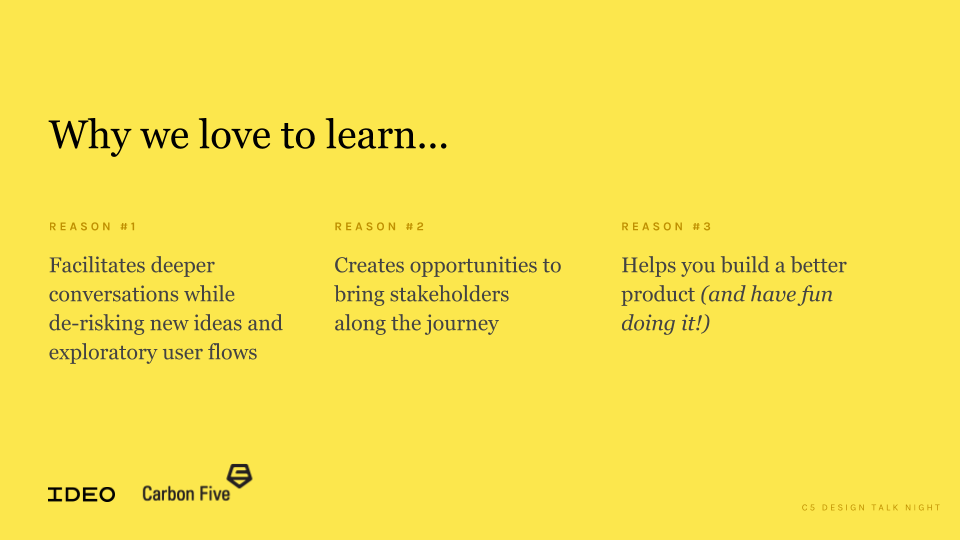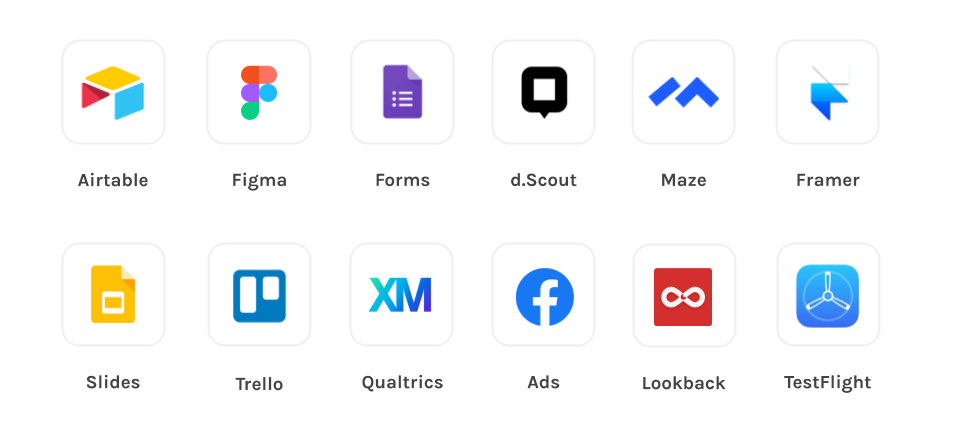
Human-Centered Learning Loops with IDEO
Carbon Five San Francisco hosts Talk Nights and invites the community to join the conversation on how we can build better products together.
This month we were joined by two guest speakers from IDEO, Kaitlyn Irvine, an Interaction Designer, and Nadia Surtees, a Design Researcher. Together, they discussed Human-Centered Learning Loops and some of their recent user research projects done by IDEO in collaboration with Carbon Five.
Kaitlyn and Nadia kicked off the event much like they do any project – with a game.
A member of the audience selected two cards from the deck that represented two potential “ creative superpowers”. He then read both cards aloud to the audience and selected which card better represented his skillset. This was repeated with a couple of fresh cards until he selected the superpower that fit him best.
Games like this one can both get useful information from a customer or teammate, and help facilitate deeper conversation by turning an awkward situation into a bonding moment. When conducting design research, it’s important to uncover truths and vulnerabilities that are not easily shared with strangers. A fun and low-barrier game can be the perfect way to get teams and research participants to warm up to the process.
Pre-Research Planning
Kaitlyn and Nadia walked through their pre-research planning, including some of the common obstacles to success around different project phases, budgets, timelines, the team’s appetite for research, and whether or not the features or content was particularly novel.
Great design research balances the constraints of all of these and takes each team member on a journey
Budget
A large budget can create more variety in research opportunities, however, a bigger budget doesn’t mean you will get better results. If you structure your research to answer the most important questions to your product you’ll get the value you need.
What do I do if I have little to no budget?
- Prioritize speaking with experts. Your design expertise combined with their subject matter expertise can build an insightful product
- Host a small gathering with potential users — co-create with them — or ask for feedback
- Start with what you have – the people around you. Ask your family and friends to do an initial gut check
- Find case studies of similar products and services – you don’t always need to reinvent the wheel to get valuable insights
- Treat someone to lunch as a thank you for an interview
Timeline
Having months to do research is a luxury typically reserved for ethnographic research where you’ll be studying behavior in multiple cities, countries, and cultures. In reality, most people get a few weeks to complete their exploration and validation research before needing to move on to optimizing.
Don’t look at a short timeline as an obstacle.
- There is always a tipping point in research when you start to see commonalities – at around 12 interviews you can typically see patterns even among diverse groups
- A shorter timeline helps you prioritize your questions
- Be selective about who you are talking to – focus on experts and save extreme cases for later
Appetite
One key to planning will be assessing your team’s appetite for research. Observe reactions to research discussions and preparation – if you sense hesitation you can adjust the next steps accordingly.
How can I get my team bought into doing more research?
- Even if you have significant time and budget start off scrappy and get a few quick wins to bring your team
- Try hosting a lunch and learn with one of your research participants. If your team hasn’t spoken with a potential user before they might have more questions to ask than they realize
- Show your team how valuable your findings can be when woven into the design process – it could incentivize them to ask for more
Complexity & Content
The amount of time you should dedicate to your research can also be affected by the amount of content you’re working with and the complexity and novelty of the scenarios that you are designing for. Be realistic with your team about the needs of your project.
Run of the mill
If your content and interaction patterns are familiar to users they will be less complex to design and build. You probably don’t need to test this as widely or deeply.
A bit of a stretch
The content will build on existing interaction patterns. These are small behavior changes that will likely require some supportive onboarding.
Completely novel
The content is a one-of-a-kind experience that will require new interaction patterns. Significant behavior change is involved, requiring careful attention to onboarding.
Being mindful researchers
At IDEO we strive to design with an intention-lens; the role of power, privilege and lived experience plays.
Kaitlyn and Nadia touched upon some of the experiences that had on recent projects where the audience they designed for was different from them in every way imaginable.
When designing and conducting research it is important to recognize the unique perspective each user will bring to the process. There are a few things you can do to ensure that your team can collect insights from the widest array of individuals.
Understand the local makeup
If you are designing research within a specific geographic region, you should understand the demographics of people in the area. With a tool like Statistical Atlas you can see the distribution of age, gender, race, and other factors. When traveling to the area prioritize meeting people who are highly connected to the community and can give you insights on challenges, benefits and share other local knowledge.
Pull direct quotes
While interviewing documents your participants’ quotes exactly – paraphrasing can lead to your own biases being added to their comments. One great way to do this is audio record the interview with the participants’ consent and listen back to the conversation to not only hear the words said but the tone of voice and pregnant pauses.
Design the process for your participants
There are a lot of great tools like DScout, Google Forms, Airtable, and others to coordinate your interviews and collect information. A word of caution here; while tools are great don’t mistake using a tool for having the answer. They are simply a way to support your team in answering the design question. Be mindful that not everyone works with technology every day. Tools that may be easy for you to operate can be challenges for others to understand a keep up with. Design your process to make it as easy as possible for users to provide feedback.

Thank you, everyone, who attended the SF Design Talk Night!
If you are interested in hearing about future events, join our Meetup Group.
If you would like to learn more about Human-Centered Design, check out resources and certificate programs from IDEO U.
